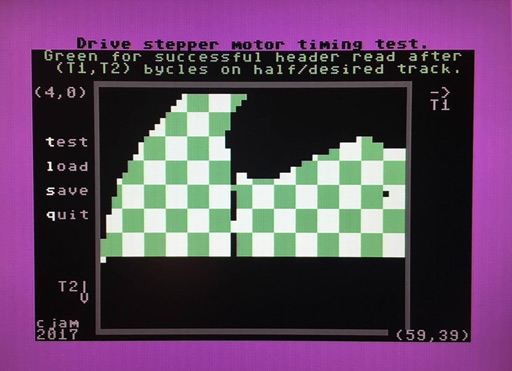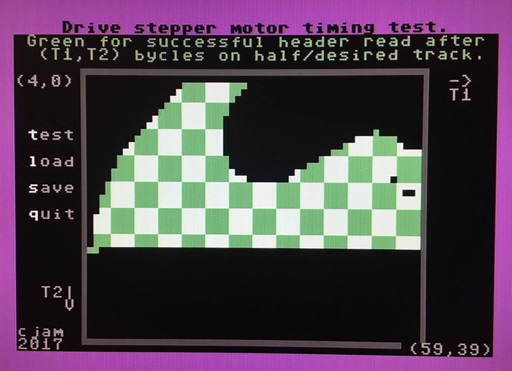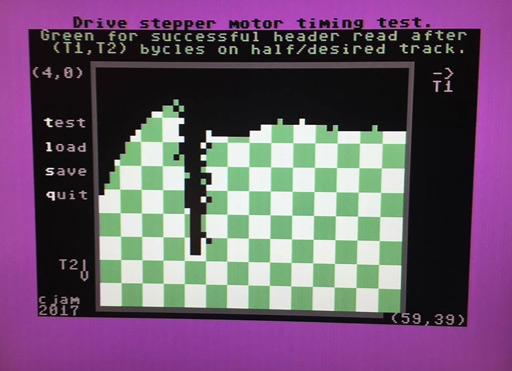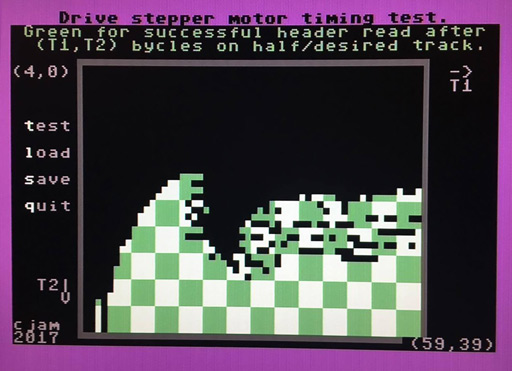| |
ChristopherJam
Registered: Aug 2004
Posts: 1409 |
Release id #160665 : Stepper Test 1.0
Copying the production notes below, but I'd really like to see some results from other people's drives for this one. |
|
... 25 posts hidden. Click here to view all posts....
|
| |
celticdesign
Registered: Oct 2005
Posts: 149 |
Neutrinos?! |
| |
Krill
Registered: Apr 2002
Posts: 2982 |
Alpha particles, more likely. But i was thinking about some possible bugs, actually. :) |
| |
chatGPZ
Registered: Dec 2001
Posts: 11391 |
i am seeing this (1541-II) - guess the ranges that are displayed must be tweaked :) (screenshot taken with chameleon, i made sure it shows exactly the same without chameleon though ;))
 |
| |
lft
Registered: Jul 2007
Posts: 369 |
THCM was kind enough to let me test Spindle on his "problem drive", and one thing I learned was that just after a track change, the head seems to oscillate a bit before coming to rest. During this time, some sectors are garbled. Perhaps the header is read correctly from one track, and then it goes back to reading from the other track halfway through the sector contents.
Disconcertingly, sometimes the sector checksum would come out right even though the contents were wrong. I didn't dig any deeper into what happens here, and I fixed it (on Bitbreaker's suggestion) by throwing away the first few sectors after a track change, until a given number of consecutive sectors with correct checksum have been read.
To research the phenomenon, I would suggest a track with some constant nibble-pattern (55 55 55...) next to a track with a different pattern (cc cc cc...), and then switch back and forth between them, reading sectors, and looking for one that has the correct checksum but some variation in the contents. This sector (and the checksum) could then be sent to the host and displayed on the screen for further analysis. Though it might not work for all nibble-patterns, so some experimentation is called for. |
| |
chatGPZ
Registered: Dec 2001
Posts: 11391 |
that "oscillating" is the "settle time" - you should be able to find this in the datasheet of the mech :) |
| |
ChristopherJam
Registered: Aug 2004
Posts: 1409 |
Krill, do you mean just the scattered individual black pixels? Head probably hasn't quite finished settling yet.
Groepaz: that drive is *fast*! Did you install a turbo?? Code would have to have a bit of a redesign to zoom any more tightly on that top edge. |
| |
ChristopherJam
Registered: Aug 2004
Posts: 1409 |
hedning kindly sent me some test images for a few of his drives last night.
1541-II (cold):

1541-II (warm):

Fairly similar to my 1541, albeit with a bit more of a wave to the right. Vestigial traces of a stall spike before it's warmed up, but otherwise quite well behaved.
The dark pixels in the bottom third of the graph is probably just the stepper test jumping a track just after the last successful test, then never recovering. I should probably fix that..
Oceanic:

A very narrow "oops I've stalled" spike here.
Dwelling on the half track for 20-24 bycles on this one is a terrible plan.
1571:

Rattletastic :) So much noise right of the spike! Interesting how much more quickly the head settles if T1 was short. |
| |
Oswald
Registered: Apr 2002
Posts: 5095 |
what is t1/t2/bycles ? :) |
| |
Krill
Registered: Apr 2002
Posts: 2982 |
A bycle is 256 cycles. It's a portmanteau of byte and cycle. This is the usual granularity with which you use timers on a VIA, especially for head stepping.
To seek to the next track, you have to skip a half-track in between. So the head is stepped two times, with T1 and T2 denoting the wait times between issueing half-track-steps or starting to read the next track.
The goal of this tool is to find a safe optimum across all drives, that is a minimal sum of T1+T2, and also to determine where to best stuff in transfer of the previous track's last block during trackstep, for overall optimisation of loading times. |
| |
soci
Registered: Sep 2003
Posts: 481 |
Possibly I've misunderstood the last sentence but I'd like to note that tracks are not aligned on real disks.
Even if it's assumed that the track skew is sort of consistent for the stock ROM format it'll be different for JiffyDOS, with a 1571 and with fast and custom formatters.
For worst case timing a track change must be assumed to be longer than a revolution (>200ms). |
| Previous - 1 | 2 | 3 | 4 - Next |

